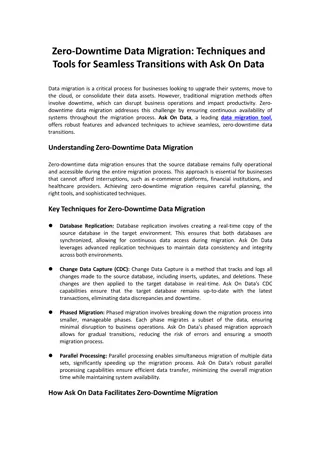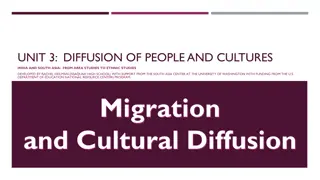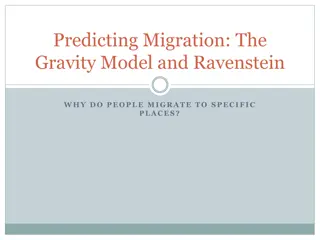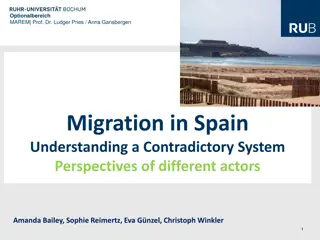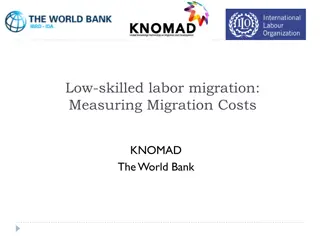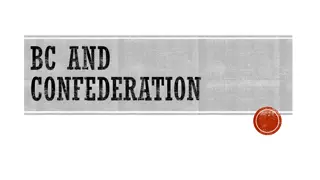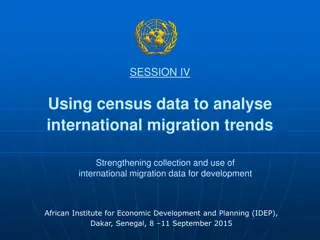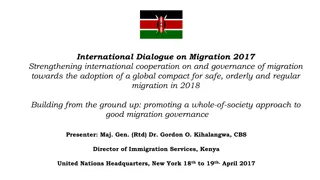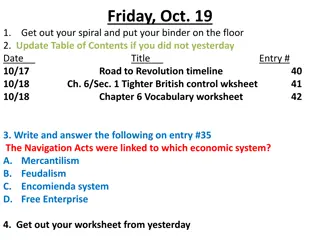British Class System and Migration to Former Colonies
The British class system categorizes individuals based on wealth, education, and occupation into working class, middle class, and upper class. Migration to former colonies like Canada played a significant role in shaping the demographics and cultural richness of these countries. The decision to immigrate often stems from seeking a better quality of life and opportunities for prosperity. This shift is evident in narratives like "Once in a House on Fire," highlighting the allure of affordable living and the potential for anyone to establish a fulfilling life abroad.
Download Presentation

Please find below an Image/Link to download the presentation.
The content on the website is provided AS IS for your information and personal use only. It may not be sold, licensed, or shared on other websites without obtaining consent from the author. Download presentation by click this link. If you encounter any issues during the download, it is possible that the publisher has removed the file from their server.
E N D
Presentation Transcript
Context: British Class System Context: British Class System Overview of the British Class System Working class - Basic low level unskilled or semi-skilled workers, such as those with no university or tertiary education. This includes occupations such as factory workers, labourers and shop staff. Middle class The vast majority of British people fall into this category such as shop owners, white-collar professionals (literally those who wear a white collar like business men and office workers), teachers, journalists, etc. Upper class A very small group of people from Lords to Dukedom are all typical members of the upper class, including the Royal family. The vast majority of their wealth is inherited. How do people fit into each category? It comes down to three main factors - wealth, education and occupation.
Context: Migration to former colonies such as Canada, Context: Migration to former colonies such as Canada, Australia, New Zealand Australia, New Zealand In the 1950s, Canada (a former British colony) needed immigrants to settle and work in the country. The Assisted Passage Loan Scheme was set up to help settlers enter the country more cheaply. Many Britons settled in the country following the introduction of the scheme. In 1978, when Andrea Ashworth s family emigrated, family members lived there already (Auntie Carla, Uncle Wayne, Auntie Penny, Uncle Charlie). For many migrants from Britain in the 1970s and 1980s, family members already resident in their chosen new country is a massive incentive to take the plunge. Vancouver, Canada
Background information Vancouver is a city in British Columbia, Canada. It is a thriving coastal seaport and, by popular opinion, is one of the most ethnically and linguistically diverse cities in Canada with statistics showing that 52% of its inhabitants speak a 1st language other than English. The city boasts scenic views, a warm climate and is recognised for its high quality of life. Perhaps this is why Andrea s family chose to emigrate? We see Lorraine explain that: The standard of living s fantastic Any Tom, Dick and Harry can afford steak for tea You don t have to be loaded if you want to build your own house These quotations alone are demonstrative of the fact that Canada s affordability of life, paired with the idea that anybody can make a life there are essentially the main two attractions which appeal most to Lorraine and Peter. Andrea and her family after arriving in Canada
Immigration Immigration plays an integral role throughout the first five chapters of Once in a House on Fire as we see Andrea s stepdad Peter and mother Lorraine make the decision to move in search of a better life. Ashworth here, alludes to the idea of escapism. It s believed that, at no time has immigration played a greater role in Canadian history than the 20th century. Particularly, between the years of 1900-1914. Canadian census of ethnic origin of 1971: 9,624,115 people of British origin formed the Canadian population=44.6% Many speculate that without the influx of immigration, Canada wouldn t be the culturally rich country that we see today.
Context: Domestic Abuse Context: Domestic Abuse Attitudes towards domestic abuse in 1970s and 1980s historical background The secrecy and stigma surrounding domestic abuse meant that friends and neighbours of victims were often unable or unwilling to provide any help or support. Working class communities were often tight-knit, with people living in close proximity to each other. In such circumstances, it was difficult to see how domestic abuse could continue. However, victims hid the truth of what went on in their homes from friends and extended family members. This is often connected with the stigma and shame associated with domestic abuse. Historically, domestic violence had been legitimised in law, religion and culture. For example, the 1895 Curfew on Wife Beating banned men from hitting their wives between 10a.m. and 7a.m. in order to protect neighbours from noise. While this was no longer legal in the 1980s, it does indicate how domestic violence was historically viewed as a private family issue, rather than a legal one. Unfortunately, this perception seemed to still ring true in many communities. People were reluctant to get involved in other people s business with the firm belief that what goes on behind closed doors is private. For many working class communities, the stereotypical image of the male provider and the lowly housewife remained a reality which made many reluctant to get involved.
Context: Domestic Abuse Context: Domestic Abuse Attitudes towards domestic abuse in 1970s and 1980s changes in attitudes take place but the process is slow and for many victims it s still not regarded as a real crime Despite the 1976 Domestic Violence Act making abuse in the home a criminal matter, there were still thousands of violent offences committed in the home which went unreported to the police. Feminists in the 1970s pushed for greater protection for victims of domestic abuse. This resulted in the first safe house being set up in 1971, which led to the creation of refuges for victims and their families throughout the country. The Domestic Violence Act of 1976 cemented their work as for the first time abusing your spouse became a crime. As a result of this, many crimes of domestic abuse were being reported and suitably punished with some abusers receiving custodial sentences. However, it appeared that the historical dominance of men over women will take time to remove. For many working class women, reporting incidence of abuse to the police was regarded as pointless as perpetrators were often given a ticking off and returned to the home. Many women reported that they didn t feel that the male dominated police force took their complaints seriously. Moreover, even if victims pressed charges and cases were heard in court, there was a general perception that violent husbands were often let off with fines, safe in the knowledge that they could return home.
Context: Poverty and unemployment in Britain in the late 1970s and 1980s Context: Poverty and unemployment in Britain in the late 1970s and 1980s Economic situation poverty/unemployment During the winter of 1978-1979, Britain was on the verge of collapse. High inflation forced the Labour government to attempt to impose low wage increases which led to strikes from public sector workers. It was known as the Winter of Discontent . In May 1979, Mrs Thatcher s Conservative government won power. The new government tried to bring inflation under control. This involved bringing the unions to heel, slashing public spending and improving industrial productivity by closing down inefficient industries. All of this succeeded, at least as far as inflation was concerned, which, by 1983, had fallen to 4%. The cost was however paid in deep cuts to the public sector, mass unemployment and the decimation of manufacturing industry. Manchester had been in steep industrial decline since the 1950s and was particularly hard hit. The city lost 207,000 manufacturing jobs between 1972 and 1984 and its unemployment rate rose to 20%. The city was also haemorrhaging people with the population of the council area (only part of the conurbation) falling from just over 700,000 after the war to around 430,000 by the end of the 1980s. Most people find it impossible to conceive how far Manchester and indeed most northern cities had fallen by the early 1980s. Andrea Ashworth was born in 1969. So she was 11 years old in 1980 when the family returned from Canada. In Chapter 6, Andrea s mother tells her daughters that they are to move from their Aunty Vera s home in Bury back to Manchester where she has secured work in the nursing home she used to work in. For a working class woman in Manchester, with three young children to support she was lucky to get any job which is probably why she decided to leave Bury and Andrea s hopes of a grammar school education behind. Throughout the memoir, we see evidence of poverty and the erosion of traditional working class male jobs.
Context: The effects of Government Housing Policies Context: The effects of Government Housing Policies In the 1960s and 1970s, housing in many big towns and cities in Britain was unfit for purpose with many residents living in slum, terraced housing with outside toilets and no central heating. There was a need to improve this and one solution for architects was to demolish many of the old terraced streets and design high rise blocks of flats creating communities in the sky . In Hulme Manchester, this was seen with the Hulme Crescents, otherwise known as The Bullring . This consisted of curved rows of low-rise flats with deck access far above the streets. Cars remained on ground level with pedestrians on concrete walkways overhead, above the smoke and fumes of the streets. These were built in 1972 and by 1992 they were demolished. There were major problems with plumbing and heating and rat infestations. Additionally, the walkways became areas where criminals could easily go undetected. Residents felt isolated. The introduction of the Right to Buy under the Housing Act 1980 was a watershed event for councils all over the country. From the start local authorities have been able to sell off their houses, but until the introduction of the RTB they were not forced to do so. Up until this time mostly the production of new homes exceeded the numbers sold, however following the passing of this policy, the period of growth halted and began a decline. Largely it led to many of the better quality council properties being purchased by tenants who qualified for the right to buy. This led to a national shortage in social housing with people who couldn t afford their own homes forced to pay higher rents to private landlords. Notice how Lorraine Ashworth finds it very difficult to find a home to rent on her arrival back from Canada and how the homes offered to them by local authorities are in bad condition.
Context: Race Relations Context: Race Relations Since before slavery, black people have been living in Britain. But only in the last 50 years have blacks and Asians settled in these shores within any great number. 1. THE EMPIRE WINDRUSH The arrival of the cruise ship Empire Windrush at Tilbury Docks on the morning of 22 June, 1948, marked the start of modern day mass immigration to Britain. On board were 492 Jamaicans, mostly young, single men, in search of work. The economic depression in post- war Britain had led to a slump in trade with the Caribbean and jobs there were short. At the same time, Britain needed rebuilding and there was a shortage of labour. The arrival of Windrush had been met with unease by some, and one MP remarked the new immigrants would be on the first boat home once the British winter set in. 2. RIVERS OF BLOOD A brilliant scholar, linguist and eloquent speaker he may have been, but former Conservative minister Enoch Powell will always be remembered for his infamous "Rivers of Blood" speech in April 1968. In the speech he warned of what he saw as the apocalyptic consequences of continued immigration of people from the Commonwealth countries. 3. RACE RELATIONS ACT The Race Relations Act 1976 enshrined many of the laws on discrimination that are taken for granted today. The act makes racial discrimination unlawful in employment, training, housing, education and the provision of goods, facilities and services. 4. BRIXTON RIOTS In 1981, violence flared up in urban centres across England as young blacks vented their anger at society and, in particular, their treatment by police. Brixton, in south London, was the first flashpoint. Nearly 400 people were injured and buildings and vehicles were set alight during the three days of rioting. Similar disturbances followed in Manchester, the Midlands, Merseyside, Bristol and Leeds. Lord Scarman led a public inquiry which settled on the so-called "rotten apples" theory - that only a few police officers were racist, most were not. The inquiry spawned new practices on the law enforcers and led to the setting up of the Police Complaints Authority, to supervise complaints against the police.
Context: Race Relations Context: Race Relations The Rise of the National Front Party (NF) The Rise of the National Front Party (NF) This is a far right political party, still around today but with no elected representatives at any level of UK government. During its heyday in the 1970s, it had a small number of local councillors, although has never secured a seat in the British Parliament. The National Front grew during the 1970s and had between 16,000 and 20,000 members by 1974, and 50 local branches.[39] Its electoral base largely consisted of some working class people who resented immigrant competition in the labour market and blamed immigrants for scarce housing. The NF fought on a platform of opposition to communism and liberalism, support for Ulster loyalism, opposition to the European Economic Community and the compulsory repatriation of new Commonwealth immigrants who had entered Britain under the British Nationality Act, 1948.[
Context: What are the main differences between grammar schools and comprehensives? Comprehensives These are also known as state schools and the majority of UK children attend them. State schools are government-funded and any child between the ages of 11 and 16 can attend. Some state schools have a sixth form attached and therefore cater for children up to 18 years of age. Grammar Schools Grammar schools are also government-funded but only children who pass their entrance exams can attend. These entrance exams are commonly known as the 11+ and are taken in year 6 (age 10/11). The exams can cover one or more of the following 4 areas: verbal reasoning, non-verbal reasoning, English and maths. The dates of the exams are set by the schools and children usually need to score 80% or more to pass the exams. Many parents start preparing their children for the 11+ exam as young as age 7. Grammar school are highly selective and have a strong emphasis on academic achievement.
1950s three types of school: Grammar; Secondary Modern; Secondary Technical Growing feeling particularly among left wingers that this system was unfair. In 1976, Labour was in power and through the 1976 Education Act attempted to get rid of selective schools. But the law they brought in didn t have a strong enough legal requirement and was therefore not very successful. In 1979, The Conservative Government (Margaret Thatcher as P.M) brought in the 1979 Education Act. This repealed Labour's 1976 Act and gave back to LEAs the right to select pupils for secondary education at 11. ------------------------------------------------------------------------------------------------------------ This created a confusing picture for England s schools. If a child lived in a local authority with a left-wing Labour council they were unlikely to attend a grammar school. However, if a child lived in an authority which had a conservative council they could apply to be tested to join the grammar school.
Context: Treatment of depression Context: Treatment of depression Depression was treated as a nervous condition and women who presented to the medical profession as depressed were largely prescribed drugs and no other help was provided. Tricyclic anti-depressants colloquially known as Mother s Little Helpers , were the only form of therapy many doctors offered patients, arriving at surgeries, presenting symptoms of depression. The major tricyclic anti-depressant, Valium, was introduced onto the market in 1963 and was the first drug doctors reached for when presented with a patient with depression. In fact, in the history of prescription medication, Valium was the first billion-dollar medicine. More prescriptions were written for Valium, globally, than for any other drug between 1969 and 1984. Side effects became a huge concern: Drowsiness and increased need for sleep were the most common side- effects and some critics argued that they were turning a whole generation of women into living zombies. Furthermore, the addictive qualities of these drugs was worrying, with some patients reporting long-term dependency on these drugs. Many critics also claimed that the medical profession were too quick to hand out drugs without investigating true causes of depression.


